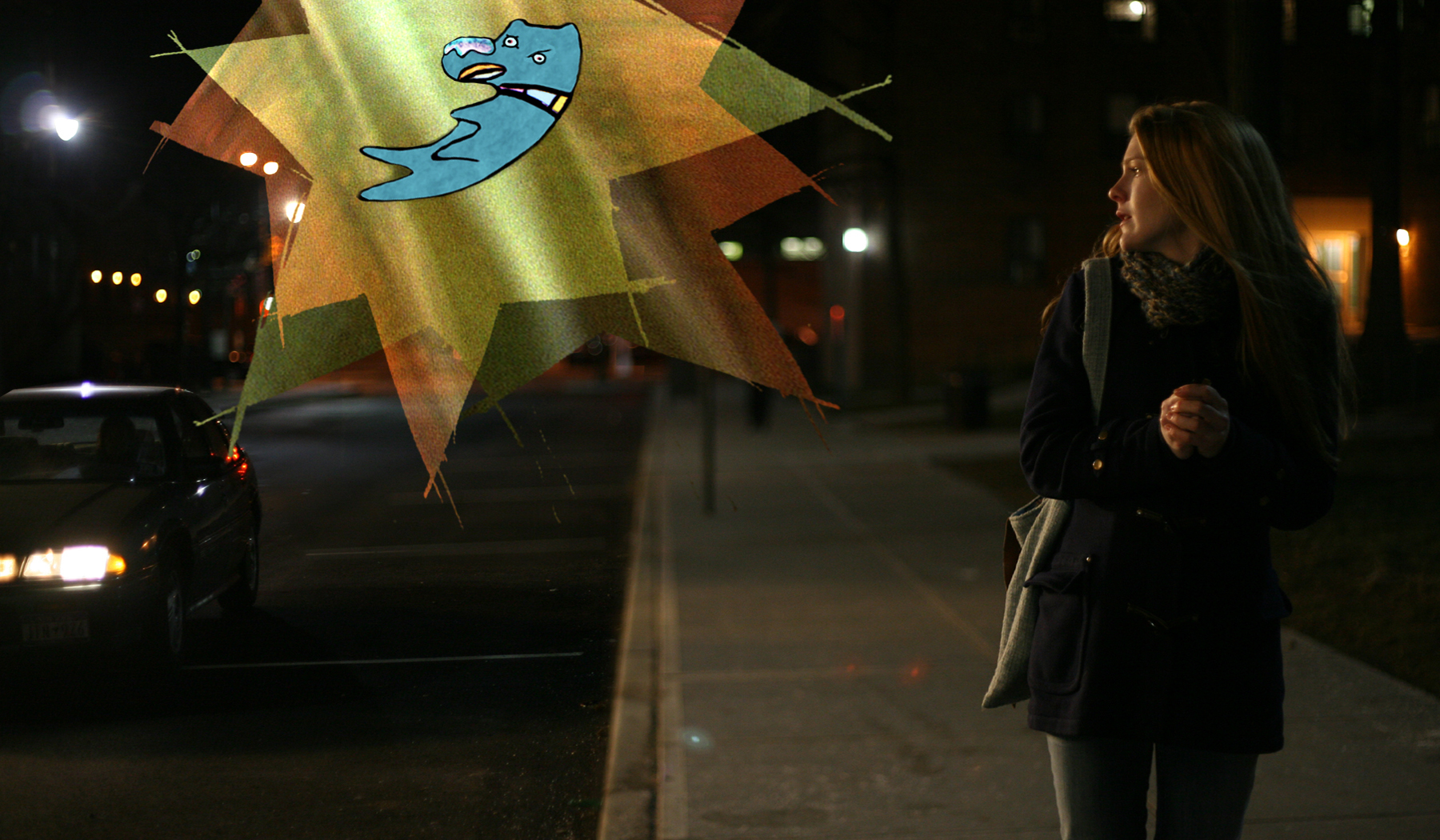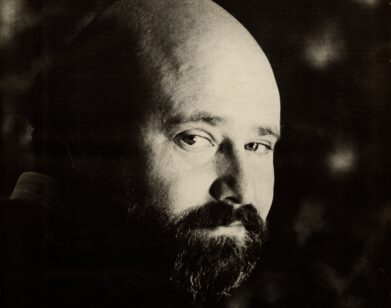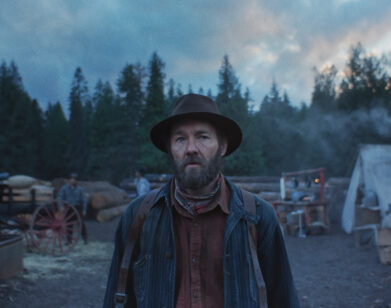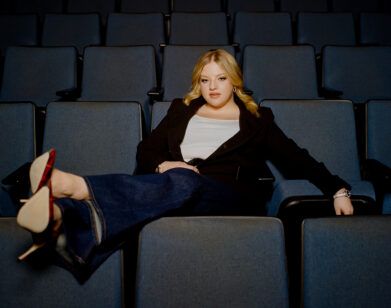Taking Tic Tac by Strategy

Lily Rabe at Mona Peek. Photo by Kristyn O’Reilly.
As Bob Dylan once crooned, Mona has got the highway blues. Mona (Lily Rabe) is also the name of the lead in The Toe Tactic, and you can tell by the way she smiles through this, animator Emily Hubley’s feature-length mixed animated and live-action debut. Triggered by the sale of her childhood home, Mona’s gloom becomes the wager in a coded card game between four animated dogs. Thanks to the canines’ tricks Mona is teamed with other outsiders, each in his or her orbit, until they’re slowly and magically shepherded back to the real world.
Hubley is best known for her acclaimed shorts and the animated sequences in John Cameron Mitchell’s cult hit Hedwig and the Angry Inch. A few days before the The Toe Tactic‘s theatrical premiere at MoMA (tonight), Hubley sat down to talk about creative trust and famous parents (Oscar-winning animators John and Faith Hubley).
JJC: You wrote the poetry that the dogs recite between their up-to-no-good maneuvers. Do you write a lot of poetry?
EH: [LAUGHS] I had never written poetry before. The words just came out, but I worked on them, and spent a lot of time with them. I just felt, at some point, I’m going to get the poetry police on me: saying ‘You are an imposter!’
JJC: Do you have a dog?
EH: I originally wrote the script thinking that there would be no animation in the movie. But as I was finishing, I got this idea: ‘But wait, you’re an animator, where do you get off writing a movie?’ Well it is, in its way, an animation because the narrative is really just the game that’s being played by the animated dogs. It’s a joke, a flip: The reality was the figment of the animation’s imagination. So that’s where it started, but then the dogs developed as characters and imposed their way.
JJC: What was it like directing actors, instead of drawing them?
EH: The cast came to the project in different ways, but it was all a matter of the script attracting them. It wasn’t me-and it certainly wasn’t the money. It was always just the characters in the story and, to some degree, the novelty. With animation, I think about living in the process of making the animation. Living in the process of making the live-action was very similar. You are totally infused in the business of making a thing from an idea. Except with the live action, you have a lot more people engaged with you.
JC: Eli Wallach is in the film. I can never imagine him as anything but the Ugly.
EH: [LAUGHS] The Good, The Bad, and the Ugly was a real obsession for me when I was growing up. He was so sharp, so on the ball. When we recorded, we recorded all the voices together, but also staggering it a bit since there were parts that each actor had to do alone. The way that it worked out was that Eli and Marian Seldes were the first actors there and the actors that were due to come after them had some real-world snag-a car stuck in traffic and so forth. I felt really bad for making them wait to record the next thing. But they were so happy to see each other and they have this whole shared history in New York theatre.
JJC: Was it different, making a short versus making a feature length?
EH: I don’t know if it’s really the length, but the scale in terms of personal process. Especially on the more recent films that I make, you discover them as you go. Putting something this big together, there’s not much space for surprises. I think there’s a lot of magic in the film and there’s a lot of stuff that I certainly didn’t predict or I didn’t understand at the time. But in my short films, it’s all like that: it’s all a process of discovery.
JJC: I just heard the Ella Fitzgerald song that your parents used in one of my favorite shorts, The Tender Game.
EH: Part of what I’m doing now is going through my parents’ archives. I just came across an interview in Norway or Sweden with my dad and him talking about Tender Game and the forms of it. These films, they come in waves.
JJC: Your sister Georgia is the drummer for Yo La Tengo, your brother Ray is a successful film editor, and you’re an esteemed animator…
EH: My parents took us on field trips and it was what fired them up. My mother didn’t have an easy childhood, so she really wanted to provide her dream childhood. We’re gonna do this now, we’re gonna do that. Sometimes we didn’t want to, but we had to go to the ballet class, the museum. I didn’t plan to be an animator, but we went to international animation festivals when we were pretty young.
JJC: Your first film screened before a non-verbal masterwork, Jacques Tati’s Trafic.
EH: He keeps coming up! I don’t know how my dad finagled that. Maybe the Elgin Theater was booking shorts that they had made. Anyway, they took me into the projection booth and were, “Listen, you’re a filmmaker now, this is your responsibility.” I was like, “Really? I just made this for my high school project.”
JJC: I love the Yo La Tengo soundtrack for Kelly Reichardt’s Old Joy and Jean Painleve’s underwater shorts.
EH: I’ve been using their music in my shorts for a long time and their music plays a very big part in my life. So there is an intimacy there. I wanted specific music: I always wanted to have themes that repeated with variation or overlapped in different ways. I also had this idea that came from my brother, that Fellini pre-scored a lot of his movies. A lot of animation is done pre-scored.
JJC: Why’s that?
EH: With animation it helps to have your story make the music work to its laws and its own creative essence, then you animate to have the full marriage, rather than trying to make the music behave to the motion. I wanted to do that as much as possible, but of course it wasn’t pragmatic to truly do it all the way. But I did ask for some themes in advance. Actually when Ray was putting together the film, he used all Yo La Tengo music, even for the temp track. If it wasn’t the music they had already scored, it was music they had made so that it was in a common language.
JJC: It probably helps that they’re family.
EH: Yeah, but they care about what they’re doing too and I trust their interpretation of the story as much as I trust my own. There were very few missed steps in that way. You just cry.
The Toe Tactic screens tonight at MoMA at 6 PM, and at various times through February 2.






